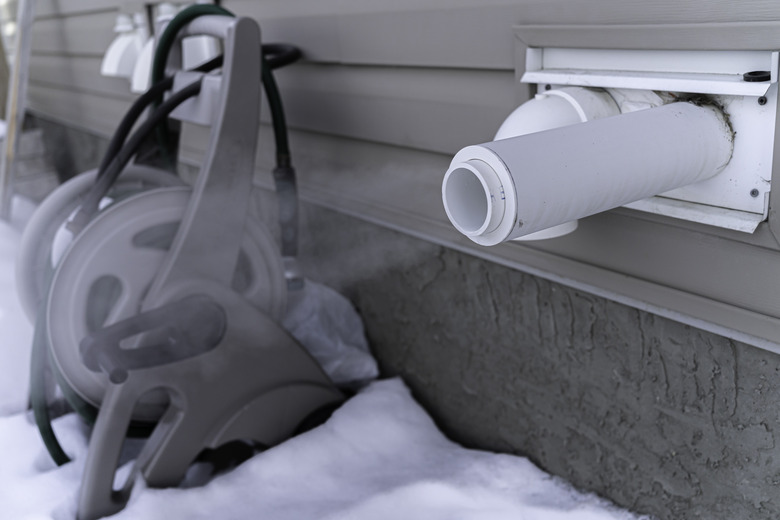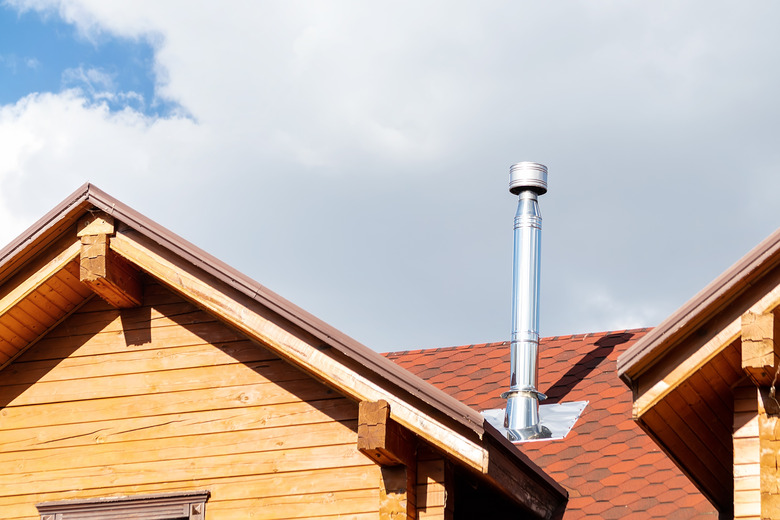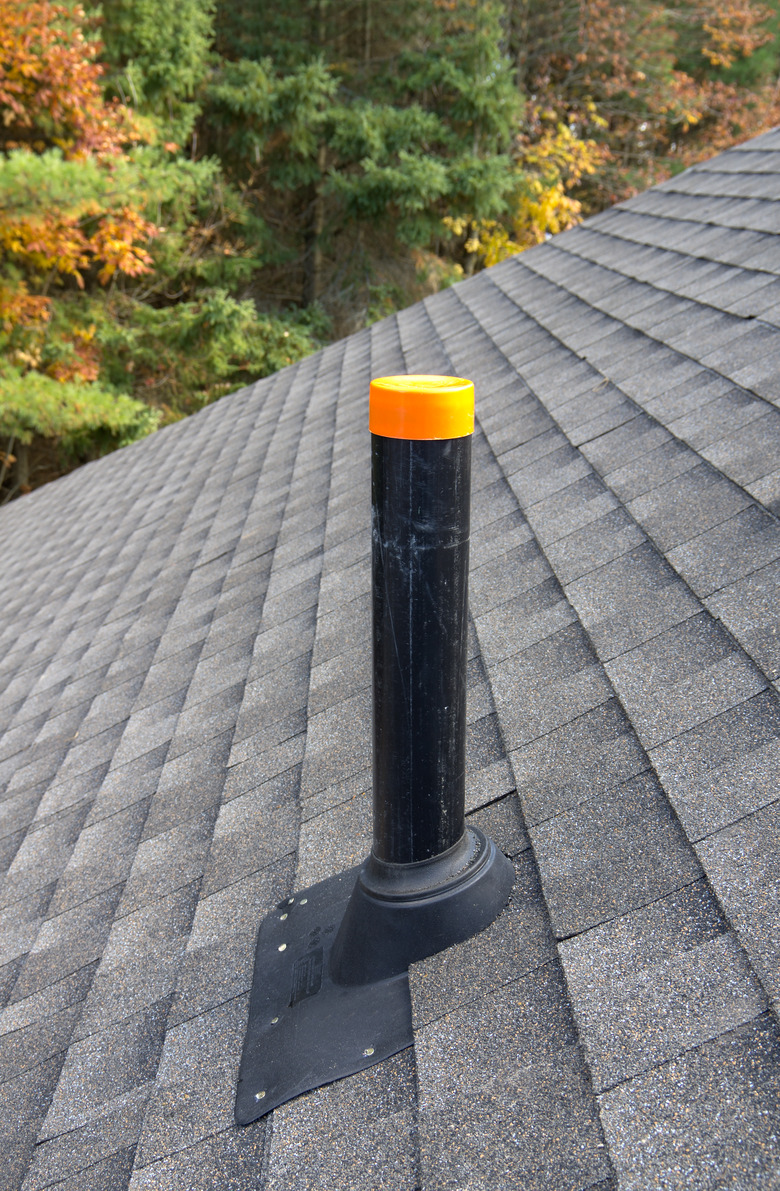Why Your Furnace Needs Proper Venting
We may receive a commission on purchases made from links.
If you've ever been stuck inside a house with the fireplace burning and the chimney blocked, you know the importance of venting. A gas furnace burns a lot cleaner than a fireplace, but it still produces enough noxious gases, like carbon monoxide, to ruin your day — and endanger your life — if they aren't directed outside the house. That's why furnaces have vents, but that's just one function of ventilation. A good venting system also ensures adequate airflow for combustion and for maintaining the pressure needed to push combustion gases through the flue and into the outside air.
If you're wondering what would happen if your furnace venting system failed, think again about being in a closed room with a fire burning in a fireplace with a blocked chimney. Not only would the room fill with smoke but the smoke would continuously get thicker because the fire would smolder instead of burning hot. That would happen because there isn't enough heat to create an updraft, which helps feed the fire by sucking room air into the fireplace. The fire would essentially be starved of oxygen and would go out but not before first driving you out of the room.
The operation of a fireplace and a furnace isn't identical, but it's similar enough for this analogy to be instructive. Unlike in a fireplace, combustion in a furnace occurs inside a closed chamber. The gases produced during combustion exhaust through a flue, or chimney, creating a convection updraft that draws in air to feed the fire. If the flue is partially or completely blocked, the gases could disperse into the room air, and the lack of an updraft would starve the fire, causing the furnace to switch off or burn cooler and waste more gas.
The Venting System on a Standard Furnace
The Venting System on a Standard Furnace
Standard furnaces are also known as 80-percent furnaces, meaning that they turn 80 percent of the fuel they burn — either natural gas or propane — into usable heat. Another way to say this is that their annual fuel utilization efficiency (AFUE) rating is around 80; furnaces are required by law to have an AFUE of at least 78. Older furnaces are standard, and the majority of them employ natural venting, meaning that like fireplace chimneys, they rely on the fact that hot air rises to exhaust combustion gases. The burners draw combustion air through a grille in the body of the furnace or through a return air duct and expel the combustion air through a flue that rises through the roof.
One of the main problems with a natural venting system is that negative pressure in the furnace enclosure or in the furnace room can pull exhaust air from the flue and circulate it in the furnace ducts. This effect, called backdrafting, could be caused by a leak in the ducts or the furnace heat exchanger or even by an exhaust fan in another part of the house that is pulling more air than it should. To prevent backdrafts, the flue is often fitted with a draft inducer, which is a fan situated near the heat exchanger.
The purpose of the draft inducer is to maintain suction in the flue and ensure that combustion gases are drawn into it and are exhausted outside. The draft inducer fan, like the furnace blower, switches on before the gas burners start and stays on for a minute or so after the burners switch off. It's regulated by a pressure switch that measures the amount of air being moved by the fan. If the air movement is less than it should be, the pressure switch will shut down the furnace to prevent exhaust gases from being drawn into the air circulation ducts.
Venting a High-Efficiency Furnace
Venting a High-Efficiency Furnace
High-efficiency furnaces have an AFUE of 90 or higher, and some have ratings of 97 to 98, which signifies almost perfect efficiency. They earn this rating by employing a dual heat exchanger, which means that instead of exhausting combustion gases outside the house, the gases are fed into a second chamber where they are condensed into liquid form, a process that extracts even more heat for circulation through the ducts. High-efficiency furnaces are also known as condensing furnaces.
The main byproducts of condensation are in liquid form and must be drained rather than dispersed into the atmosphere. Carbon dioxide and water combine to form carbonic acid, which is a corrosive solution that would quickly eat through steel, so it must be drained with PVC pipe. The pipe slopes from the bottom of the furnace through the sidewall of the building, and the furnace is tilted slightly to ensure all the acidic water flows into the drain.
For a high-efficiency furnace one of two ventilation systems may be used. In a direct-vent system, one vertical pipe exhausts combustion gases (because all the heat has been removed, this pipe doesn't have to be metal, so it's usually PVC), and a second pipe (also PVC) draws in fresh air for combustion. A furnace situated in an area with good air circulation can have nondirect venting, which means it's designed to draw in combustion air from its surroundings through a port or grille on the furnace body and needs only a single PVC vent pipe to exhaust combustion gases.
What Can Go Wrong With Furnace Venting?
What Can Go Wrong With Furnace Venting?
A gas furnace vent can get blocked, or it can leak, and because the vent serves two different purposes, the consequences can show up in two different ways. Blockages or leaks in the intake vent primarily affect the furnace itself. It gets starved of oxygen and burns less efficiently, possibly even producing smoke that is visible in the furnace exhaust. The furnace runs less efficiently, and monthly fuel expenses increase, and the ultimate cause can be something as simple as a dirty intake filter that the homeowner has been forgetting to change.
A blockage or obstruction in the exhaust vent can affect both the occupants of the building and the furnace itself, and the effects can be dire, but fortunately, the furnace will usually shut down before things get dangerous. If the exhaust gases can't escape, the furnace will overheat, and the high limit switch will shut it off. Unfortunately, some of the combustion gases, including carbon monoxide, will circulate through the ductwork before the shutdown occurs, which is why every house should be equipped with carbon monoxide (CO) detectors to protect home dwellers from inhaling it.
Because high-efficiency furnaces produce condensate as well as combustion gases, vent pipes that run horizontally must have a minimum slope or 1/4 inch per foot toward the drainage point to ensure that water doesn't pool inside the pipe. The water can restrict airflow and attract debris, which restricts the flow even more, and the furnace becomes less efficient. Because they are made of PVC, the vent pipes can come apart if they aren't installed correctly or with the right type of glue. Leaking exhaust pipes release CO and other gases into the plenum, and the blower can circulate the gases throughout the home.
Moisture in the HVAC System
Moisture in the HVAC System
Air conditioning and heat pump systems include evaporator coils inside the plenum, and they are positioned directly in front of the ducts or just above the heat exchanger in a combination air conditioning/heating system. When refrigerant is circulating and the coils are cold, moisture from the surrounding warm air condenses around the coils, drips into a drainage pan and is directed out of the unit. If buildup in the pipe prevents drainage, moisture can circulate and promote mold growth in the ductwork.
There's also a potential for this happening with a high-efficiency furnace if condensate is allowed to accumulate, although because the moist air is warm, there's a better chance it will get blown through the registers and into the house, where mold can grow on the walls. Water is one of the byproducts of combustion, so a high-efficiency furnace also blows moisture into the house if it isn't exhausting properly, or the exhaust vents are leaking. If you see mold growing on a central air register or a nearby wall, your furnace could be experiencing this problem.
Mold is dangerous wherever it's growing, but it's especially pernicious when growing inside the central air ducts because the blower can spread spores throughout the house. The Environmental Protection Agency (EPA) cites visible mold growth as one of three legitimate reasons for hiring a duct cleaning company, but the problem doesn't end with the ducts. A furnace or central air system blowing moist air needs to be inspected for leaks and other problems as soon as possible.
Inspecting a Furnace Venting System
Inspecting a Furnace Venting System
A thorough inspection of the venting system is part of a regular furnace tune-up, which should be scheduled once a year, preferably in the fall before the cold weather comes. The HVAC technician conducting the tune-up will check for leaks in the vent pipes and flue as well as the ductwork immediately around the furnace and inspect all ductwork joints, re-taping those that are loose with aluminum foil tape. The tech will also verify that the condensate drainage pipe is working, that the inside of the furnace enclosure is dry and that the draft inducer — if there is one — is working properly.
When checking the vents, the tech will also inspect the vent pipe opening outside the building for blockages and will clear any that are evident. Because the vents for high-efficiency furnaces don't expel hot air, they are especially vulnerable to birds and small animals seeking refuge from the elements. Critters can also find their way into the furnace ductwork, and as far as the EPA is concerned, finding evidence of nests or insect infestations is a second reason to have the vents professionally cleaned. The only other condition that warrants professional duct cleaning, according to the EPA, is when you see particulate matter being blown out of your heating or cooling registers.
Because adequate airflow is so vital to the safe and efficient operation of the furnace, all air filters should be changed periodically, and that's something for which you don't have to wait for a service pro. The intake filter on the furnace housing is inexpensive and easy to remove, so it should be replaced every three months during the winter when the furnace is working full time and just as often in the summer if you have a central air conditioner. You can also take the opportunity to lift the covers off the vent register and look for dirt buildup or mold, using soap and water to clean it up if you find any.
References
- Structure Tech: Can You Install a High-Efficiency Furnace With Only One Pipe?
- Wm. Henderson Plumbing Heating Cooling Services: How Does a Furnace Vent Gas? 3 Types of Vents & Benefits
- AccuServ Heating & Air Conditioning: Quality #1 – Where There's Smoke, There Might Be Bad Venting
- Hydes: What is a Draft Inducer and How Does it Improve the Performance of Your Furnace?
- Farnen & Dermer: 4 Things You Need to Know About High-Efficiency Furnace Venting
- HVAC School: Combustion Air
- Consumer Reports: Gas Furnace Buying Guide


